On Canal de la Marne au Rhin Est
20th to 26th July 2022
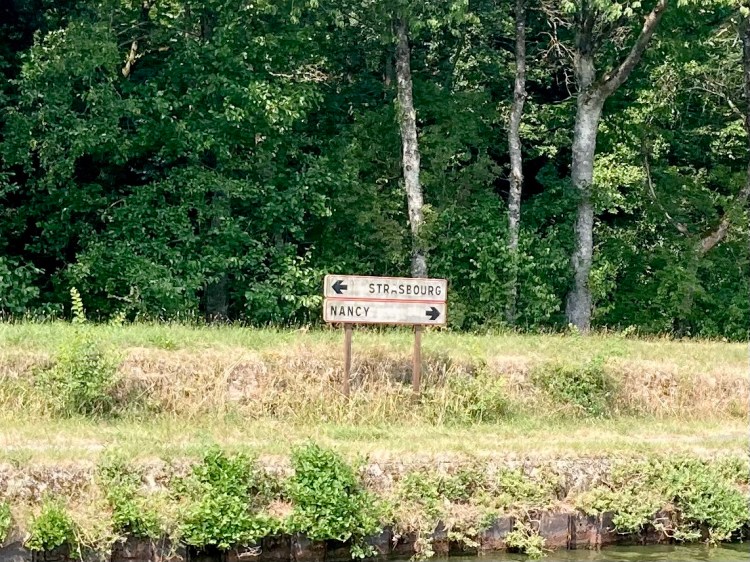
As we came to the end of the Canal de la Sarre we reached a T-junction and the sign above. For now it was an easy choice – we were heading for Strasbourg where our niece and her family would join us for a few days.
After their visit we might come back this way and travel towards Nancy – if the canals in that direction had not all closed. We were in the middle of a second heatwave and long weeks without much rain. The waterways of France were drying up; many had an ‘arrète de navigation’. But that is me getting ahead of myself.


We were now on the eastern branch of the Canal de la Marne au Rhin. Our last canal had brought us up to the heights of the Sarre river and we found ourselves looking down at the landscape, rather than up to the hills of the past weeks.

Our first stop was at Xouaxange. We had several attempts at pronouncing it and I am not sure if we ever got it right. The internet was not much help, suggesting equally unpronounceable phonetics. We found a nice empty quay in a simple park setting, and were joined later by some other boats, and camper vans.


It is a small village, with a few nice structures. These include the bridge from the quay to the village, and the church with its unusual tower.
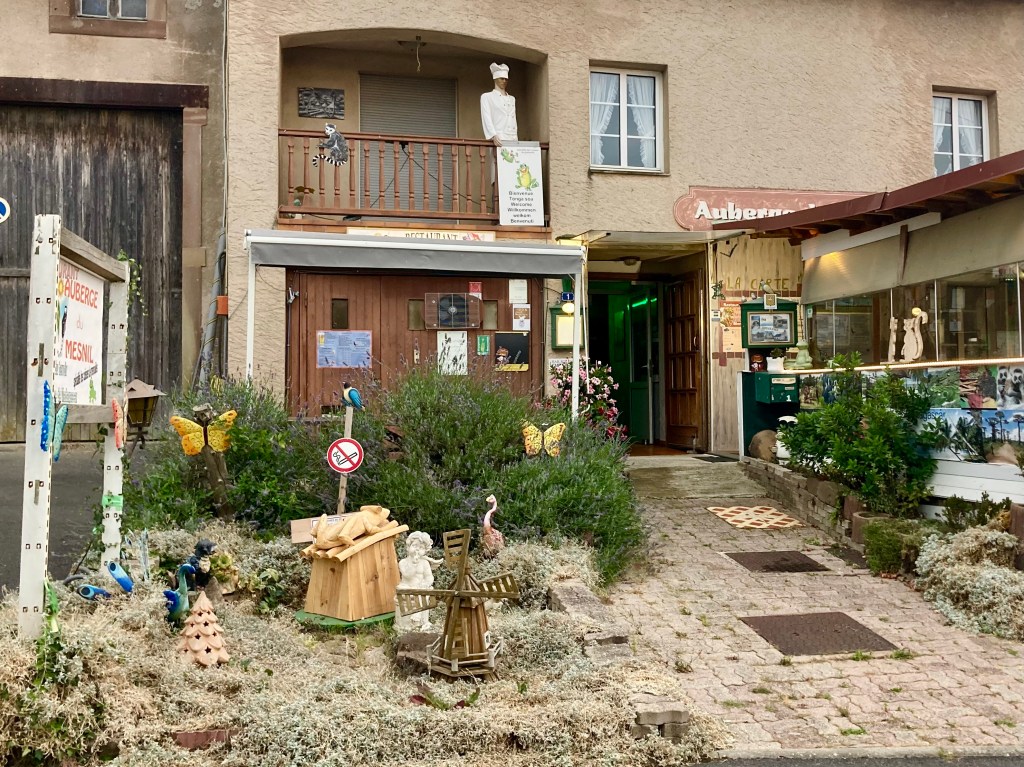


An earlier decision had been made to eat out; we were short on provisions after several pleasant quiet rural moorings. There appeared to be one restaurant in the village and it was not the French cuisine we expected!
It was a very friendly, slightly quirky place with a mainly Madagascan menu. It began to rain (very welcome) as we approached so we sat inside next to an open window and enjoyed a tasty different kind of meal.
It did not rain for long, despite my rain dances and the country’s prayers.

By next morning when we left the skies were mainly blue again, but there was a freshness to the air that had been missing for a while.
The canal leading out of Xouaxange was narrow and on a long curve, following the line of a hill; lovely cruising as long as you don’t meet anything.
We didn’t.


One reason for the narrowness was that we were about to cross a short aqueduct over the very upper limits of the River Sarre. It was proud to describe itself as one of the first (maybe the first) steel built aqueduct in the country, and is appropriately named Aqueduct de la Forge.
We had joined the Sarre on 29 June, where it joined the Moselle in Germany. At that point it had its German name – the Saar. Three weeks later we were looking at its beginnings – the first full journey of a river for us.

We continued along our high plateau looking at at countryside that was greener than it should have been after the dry spell. Maybe last night’s rain has got to work already.
Captain and crew had been wondering what mechanism would be used to open and operate the locks, bridges, tunnels etc along this canal. We had handed in our remote control for the locks on Canal de la Sarre and were watching for clues.
The answer came big and bold!
We were coming up to two tunnels and a system of ‘detection’ was in place to know when a boat arrived at the end of the tunnel. We had to moor up behind a holiday boat that was already there and wait for the traffic lights to turn green.
After a while two boats appeared from the first, shorter, tunnel (Niderviller) and it was our turn to proceed.
As usual there was a long narrow cut leading to the tunnel entrance; we followed the holiday boat into the darkness.


At the other end we were required to wait again at a second ‘detection’ point – and again behind the holiday boat, which was tackling the tunnels quite a bit faster than us! I guess it’s not his own paintwork that is at risk.
This time, unusually, there was a second tunnel alongside the one for the canal. This was for the railway and trains came rushing past as we waited.
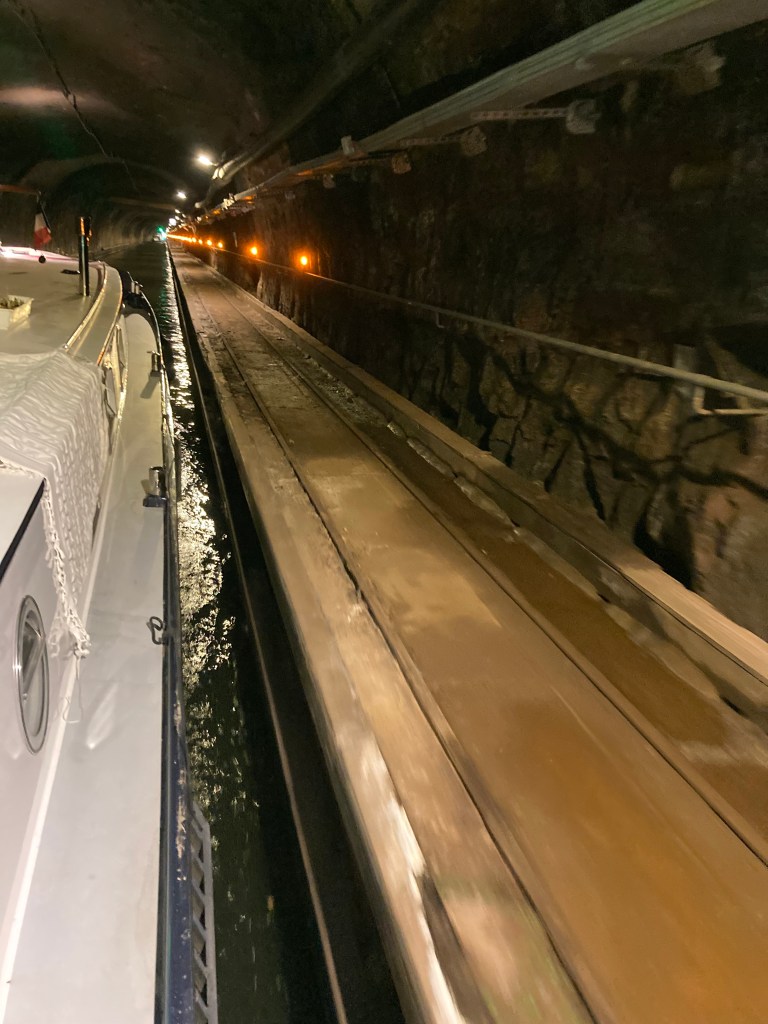

Then it was our turn for souterrain (tunnel) two – Arzviller – the longer of the two.
Stu had noticed a wooden ‘guide rail’ at approximate zig-zag fender height in Niderviller tunnel, and in the hope of the same construction here he gently steered towards the starboard side of the tunnel. I adjusted the zigzags to match the guide rail and Calliope glided through.
We emerged into a wide right angled basin – the ‘gathering and waiting area for the Inclined Plane of Arzviller.

The plane replaced, in the 1960’s, a series of 17 locks that took the canal slowly up a wooded valley – very beautiful, but also very slow for the working barges that were using it at the time.
As only 38.5m (length) of boats can go up or down at one time we were expecting to wait until there was a suitable space for Calliope’s 19.8m. The length was designed to carry the 38.5m freycinet working barges of the late nineteenth and twentieth centuries.
In fact we waited two hours, firstly in a queue of other leisure boats, and then because the passenger boat took precedence over us. People can buy a ticket to go on a passenger boat down and back up the plane, plus a small cruise.
But that was fine because we were able to get a good look at what was going on.
I found a good vantage point to watch the caisson (watertight box) come up the plane with three boats inside.

Then I had time to go into the building where you can see the huge winding wheels.
A sense of scale is seen when you notice the white van at the far side of the photo!
Next I watched the tank fill up with boats at the top, and make its slow majestic way down the side of the hill to the lake below, where the boats are able to ‘disembark’ as a door rises at the front of the caisson.
For those wanting to know more about this monumental structure you can read it here. https://en.wikipedia.org/wiki/Saint-Louis-Arzviller_inclined_plane
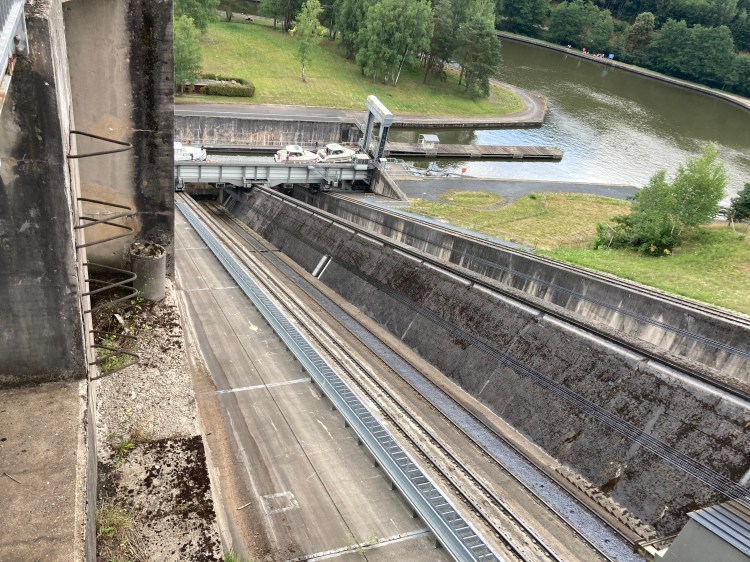

At last it was our turn and we entered the caission. This was our view, from Calliope down to the bottom.



Here are three photos to show aspects of our descent. In the centre photo one can see the door to the caisson lifting up to let us out – with cooling water dripping down on the crew’s head!

We moored up for the night below the plane – and in plain sight of it!
In many ways it is a lovely peaceful mooring, although the road on the opposite side of the lake has fairly constant traffic during the day – not quite what we expected.

The first interesting thing we passed next morning was the entrance to the first of the 17 locks mentioned above. We have heard that the walk up past these old locks is well worth doing, but with our need to get to Strasbourg we could not stop this time.
It’s on our list for next time though.
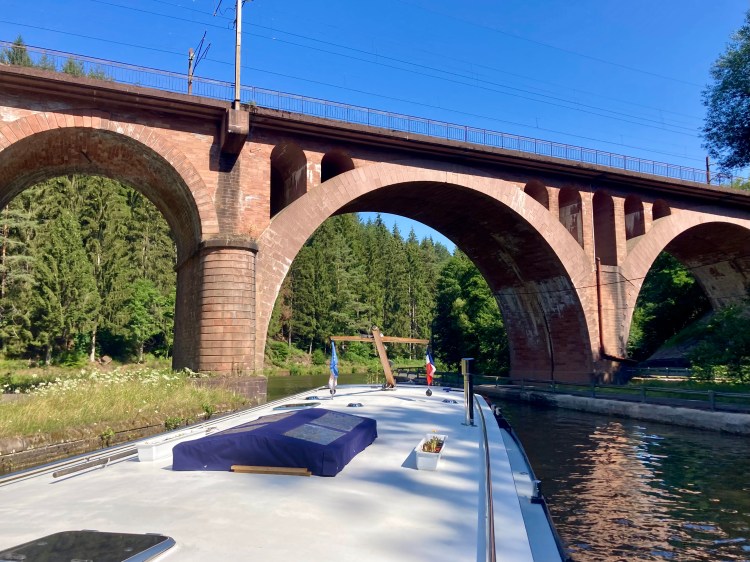
There are so many fascinating and architecturally interesting structures as you pass along a canal – here is a rather lovely railway bridge, beautifully constructed of mellow bricks.


Now the wooded hills on this side of the uplands are becoming more obvious.
Locks are definitely downwards; lock houses are yet another design. One day I will collect together on one post all the many shapes and sizes of lock keepers houses we have seen.

By now we were getting closer to our overnight stop. Lutzelbourg castle could be seen atop a hill as we continued descending towards the town.

On the way into Lutzelbourg we saw an example of the little engines that pulled barges along the canals and through the tunnels for a short time between the days of horse drawn boats, and the era of boats with their own internal engines.
Initially these were apparently electric (not sure how), and later were run on diesel.

Coming into Lutzelbourg was a revelation. We had no idea that it would be such a pretty little place – almost Alpine in the way it clings to the side of the hill.
As we came through the lock above the long mooring we were able to look around a bit and see the river Zorn below us.
The other half of the town is down there, the other side of the river. .
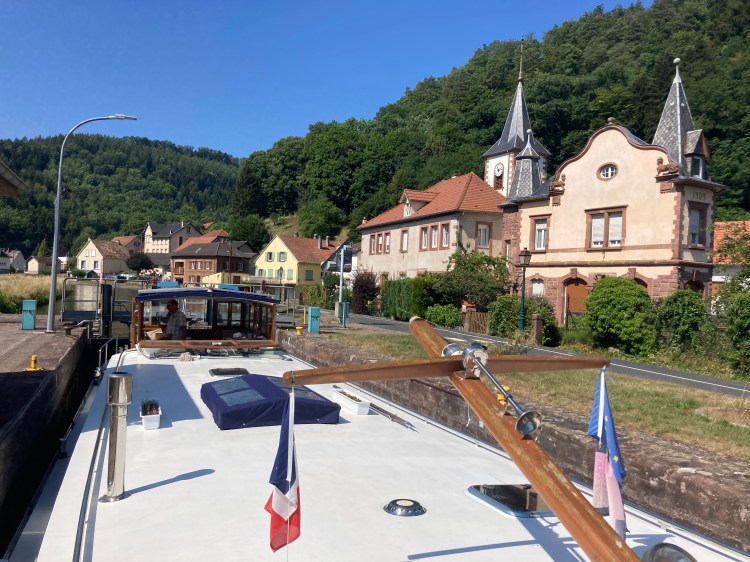

And then we were there – tied up alone on a long long mooring in (rather hot) sunshine and with green forests all around; wonderful yet again!
Once more we were not to be alone for long!

Luckily we had, as usual, moored up by 1130. This second photo is the quay at 4pm.
It was nice to see so many people enjoying the canal. After all it is what keeps them open and navigable.
We did find a rather nice small shop in Lutzelbourg, with a good mix of fresh local cheese, vegetables and meat, wine and beer, and a reasonable array of dry goods too.
Almost next door was an excellent boulangerie, and across the street a few restaurants – including the one we chose for a summer’s evening pizza.

We watched with interest next morning as the ‘great get away’ began.There are locks either end of the long mooring, so whichever way the boats were headed there would be a queue for the lock.
We waited a while until there seemed to be a queue of one in our direction and set off down stream.
One of the effects of the lack of water is that boaters are asked to share locks with other boats to save water. We were therefore expecting to share with the boat ahead of us, but they moored in the centre of the lock. Despite our polite calls in English and French they did not seem to understand so Captain ‘hove to’ and we prepared to wait our turn.
A passing lock keeper was not too pleased about this. He recognised it was not our decision not to share, and told us he had called ahead to the next lock to hold up the boat in front until we arrived to share!
At the next lock we discovered a very nice Norwegian family who had only collected their boat the day before. The previous lock was the first they had ever been through and to them our 20m barge looked much too big to fit with them.

But we soon got a system going for the pair of us and continued all morning sharing locks with them, getting to know them more and more in each one.
Down and down we went, through the trees and valley, with each turn as beautiful as the one before.
We passed plenty of lock houses, this one ready for winter already with a good stack of wood outside.

Both boats were on their way to Saverne for the night and our last lock as we entered town was a bit more of a challenge, both in turns of its structure (with a high sill at the top end) and the audience of ‘lunchers’ at the two restaurants alongside!
It is also twice as deep as all the previous locks as two locks have been combined into one. So it looked a bit awesome to our Norwegian friends.
Initially we were trying to space the two boats out to allow us all access to the bollards in the wall of the lock, allowing us to move the ropes down as the water level dropped. But then Stewart noticed that there were ‘sliding poles’; metal poles the full depth of the lock to put a rope round and ‘slide down’. That made it easier for us.
We all came through unscathed. I wish I had photos as it was an interesting experience, but it was a busy time!
There is a big modern marina at Saverne, with open air bar and food stalls, mini golf, and generally a nice place to relax – but it was full. So we continued round the corner to the stretch of the canal pictured above. The first section, complete with water, electricity and boards, is still part of the marina. This was also full (disregard the empty space you can see as mooring was not allowed there the day we arrived.
We went on to the end of the line, grabbed the mooring pins and a hammer, and jumped ashore to make fast! We are the second to last boat along, inn the distance. The last boat was our Norwegian friends.
I was soon off to find a supermarket and buy some good fresh produce. This meant crossing a bridge, where I took this photo.

In fact it turned out to be a quiet and pleasant mooring.
The Norwegians and their holiday boat were scooped up by the Capitaine of the marina as they needed water.
That left us at the end, right at the edge of everything, for the night.

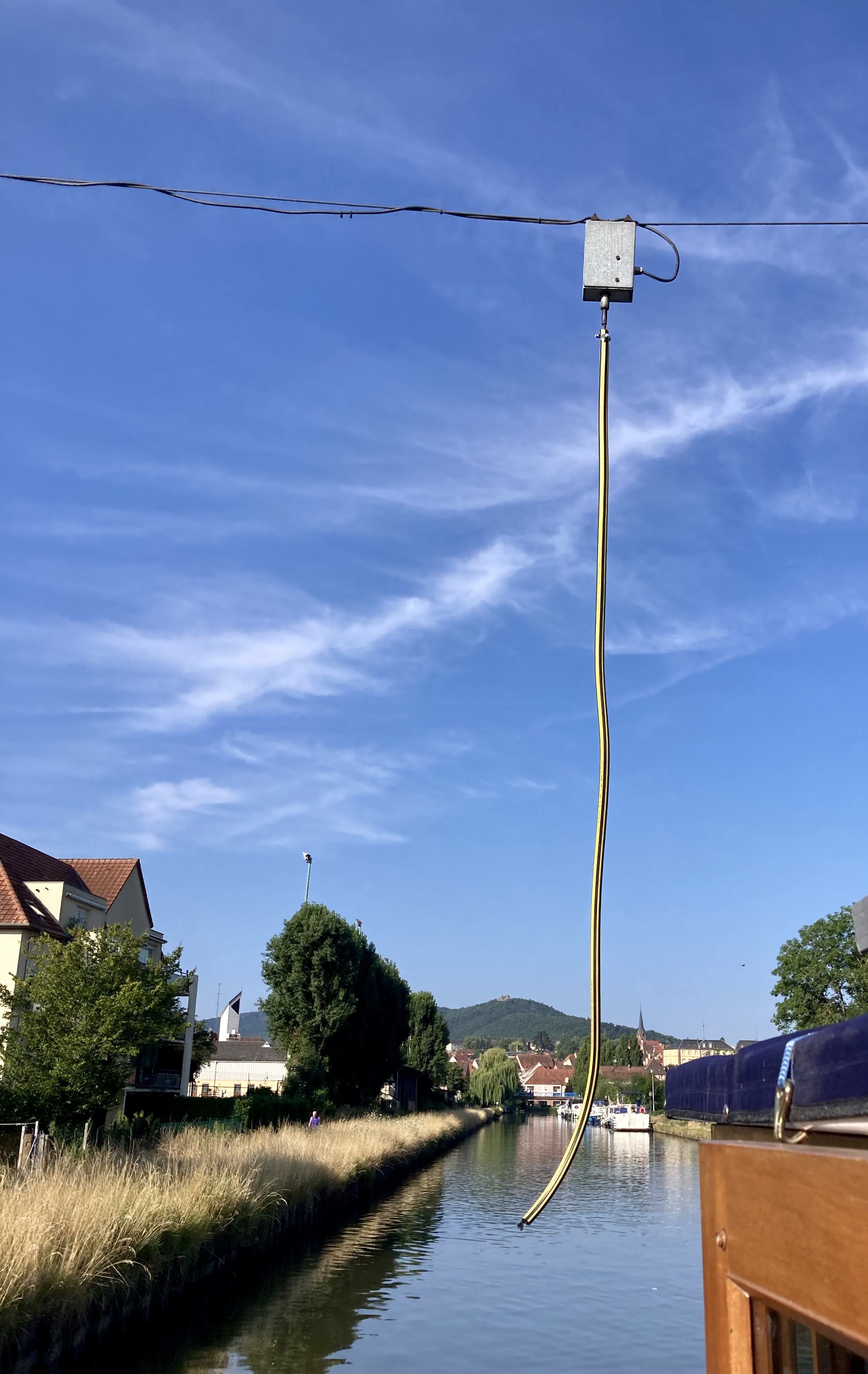
All ther locks since we joined this canal had been set on motion by sensors that knew we were approaching.
It was therefore lucky next day that we suddenly caught sight of a pole suspended above the water and in the shadow of the tree on the right a sign saying ‘Tirez Ziehen Pull’.
We were back to the most fun of the lock initiators – the pole to turn, or in this case pull, suspended above the canal. It then reopen ds on the helmsman’s skill in taking Calliope close enough, and the crew’s coordination, to hang on with one hand and reach out for the pole with the other.
Although, to be honest, Stu is such a good Captain that I can usually reach the pole with no exertion.

While I am mentioning canal side signs, here is a nice example of the old and new together – the old stone kilometre marker, and the new PK sign for the same point.
It was another scorching hot day and we were glad to have the front windscreen down, back doors open, and a breeze able to blow through the wheelhouse as we moved through the countryside.
There was no dozing off ih the heat though. Apart from several locks to descend there were also narrows in the canal where bridges passed over.
Some look impossible to squeeze through as we approached them, but I guess they are the same width as the locks.
Anyway Stewart steered us through them all with no bumps or scrapes.
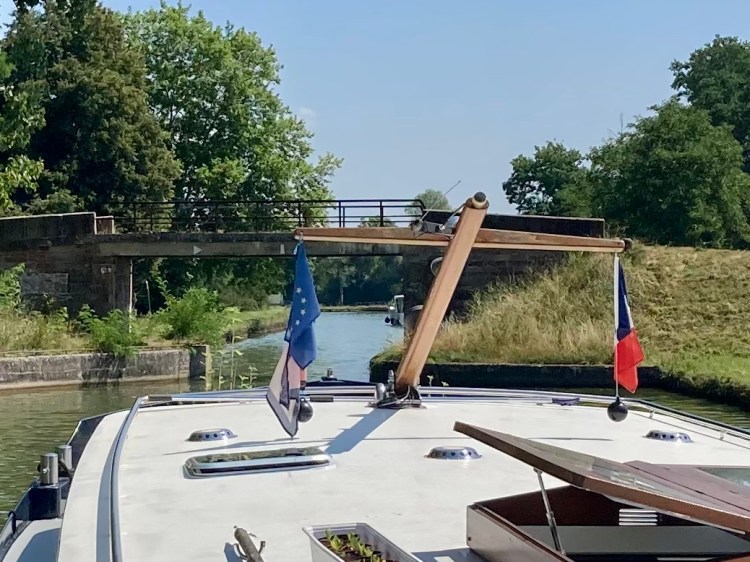
Our next mooring was one of the most magical ever! It was a kilometre or two from the village of Ingenheim, out in the countryside, and so so quiet that most of the time we could not hear anything! Not even a bird.
There are just three yellow bollards set into the grass bank – but that is just enough to make an easy secure mooring.
Next to us, and the reason for occasional short term company, was an old boat imaginatively converted into a rest place for cyclists and walkers. A hut at one end provided shelter from rain or sun; a barbecue could be used by those with the food and fuel; and there were cycle stands at the front plus flowers for decor.




I have mentioned that it was hot – maybe 36°C – so many wasy were deployed to keep core temperature down!
Supper was preceded by long drinks in the shade of the bankside trees; the river Zorn, a short walk away, was a cooling place to paddle and sit in the shallows; hair was tied up any-old-how off my neck; and the Red Ensign jooined forcwes with the parasol to keep the sun from the back deck.
Together these measures meant we had a really pleasant summers day and night at Ingenheim.
As the sun went down, around 9pm. I went up to the nearby bridge to try and capture the lazy evening atmosphere.
Our mooring, and Calliope, can ben seen adjacent to the trees on the right.


In the other direction, towards the village, the sky was fading from blue to pink.
The end of a beautiful day.
Next time I want to stay there longer!
But as you know, we had a deadline to meet so next morning, an other blue-sky day, Stu reorganised our fenders while I walked up to the next lock, just half a kilometre ahead.
The lock system had changed again. Now we were in a loose ‘chain’ where each subsequent lock was expecting you to arrive. But we had ‘broken’ the chain by stopping overnight and I now needed to go to the lock and call up the VNF to open it for us.

I could have called from the boat using my mobile, but I like the exercise of the walk in the cooler morning air.
And its lovely to be off the boat and able to watch her glide up through the water, a scattering of ducklings ahead of her and last night’s mooring behind.

Mother duck and her babies kept out of the way, popping up in the breakwater by the lock.
The lock house here, at Lock 41, is yet another of the abandoned ones. What a place to be able to buy, revamp and live in.

It was a bit of a day for birds, but not good photos.
Nonetheless here is a parenting Egyptian goose with some of his/her goslings …..

…. and here is one of many storks we saw in the fields, but they are never close enough to be in good focus.


When we were cruising on the south of France, on the Midi and Garonne, we often saw golden fields stretching away from us, full of sunflowers. And I managed to grow quite large and glorious sunflowers aboard as well.
This year had been disappointing up to here, but suddenly we had a field of sunflowers, and my first bud showed signs of opening!
Coming on down towards the Rhine valley we realised we were getting closer to civilisation as we passed a working barge.
(Later, moored in Strasbourg, this barge passed us on an almost daily basis, moving up and down the canal carrying cement.)


Thos of you who have read a few of my blogs will know that I have a certain love of the differences I find in locks.
We often see white or yellow lines painted on the wall of a lock below the position of a bollard so that you know where to throw your rope when deep down in the lock and unable to see the quayside.
On this occasion as well as a white/yellow mark, there was also the outline of a bollard shape cut into the lock wall.
Rather lovely I thought.
By lunchtime we had arrived at Foret de Brumath – a mooring described as being rather gravelly and dusty. It was both those things at the commercial end, but quite pleasant and close to the trees at the leisure boat end. We tied up and waited for the sun to move round and bring the shade of the forest over Calliope.

As the afternoon drew on and the shadows lengthened towards us we were surpised to see another boat – another Piper boat – appear from the Strasbourg direction.
Naturally we went to help with mooring and discovered Gabriel, owner of Vagabonde and Capitaine of the harbour at Kembs, handling his boat single handedly.
We were invited on board later and had one of those unexpected delightful evenings of Franglais conversation, champagne and chocolate!
Thank you Gabriel – our turn next.


All to soon it was the next day and the parting of the ways – Gabriel continuing upstream for a short holiday, and us onwards towards Strasbourg.
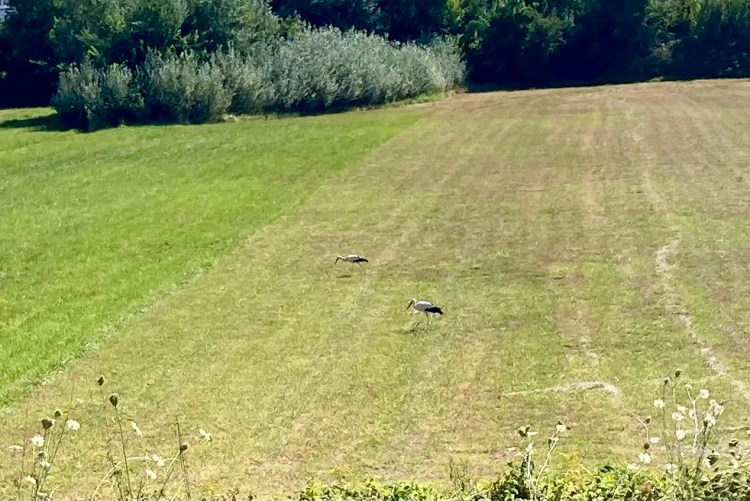
I just mention that we passsed lots more storks – with their images captured no better than the ones before!


Easier to see, and more interesting to some, was the swing bridge at Vendemheim. (Have you noticed how Germanic many of the names are around here? Of course Alsace is onie of those areas that has swung back and forth between nations over time).
The bridge was shortly after two locks – all three structures controlled from the building at Lock 47. When we arrived there was small queue. It seemed that there had been a fault in one lock, boats of various sizes waiting to go in both directions, and also one holiday boat that had broken down all together. All they could tell us was that their engine had stopped working. We did not feel capable of helping, and they were not in any danger, so we had to leave them behind.
After the suburbs of Vandenheim we only had 10 kilometres and 3 more locks to go before we were well and truly in Strasbourg and looking at the visionary building that holds the European Parliament.
Sadly this is a place without British representation any more, but we can still admire the reflective curved walls.
I think we had just the right kind of sun and clouds for this photo – lucky me.

The next marvel was the Russian Orthodox church on the junction of the Canal de la Marne au Rhin and the Bassin des Ramparts.
This is where we turned to starboard, heading along the basin towards the Port d’Europe and our mooring.

We cruised past a long line of old barges, some now houseboats and others waiting for new life to be injected into them.
Then we spied the port and the fuel pontoon where we had been told to wait until directed to our final mooring. We ‘double parked’ against another big barge – Melba – who were waiting for their mooring to be free. Naturally we got chatting, and when we all moved too our pontoons we found ourselves moored directly behind her! Mark and Debra are now firm friends.
Relaxing that evening in the knowledge we had got to Strasbourg a day before our guests arrived we looked out over the port and marvelled that yet again we had been lucky enough to get an ‘end of pontoon’ mooring with our back deck open to this view.
As the sun set we planned our route by tram to the station the next day to meet up with Jo, Warren and Ollie.
Our last quiet evening for a few (fun filled) days).


And here they all are – well Warren took the photo. And it is not of their first evening, but of one of the breakfasts we enjoyed.
Warren and I liked the walk through the citadel park to the boulangerie for fresh croissants, pain au chocolate, croissant armandes, pain au raisin and anything else that looked tasty!
Well balanced of course by fruit and juice!



Of course having visitors gave us the perfect excuase to be tourists in this fascinating city, We all set off together and over their stay we sam any of the sights.
One of the best for us was seeing a statue of Calliope – the muse of epic poetry – on top of the opera house with the other muses. There she is – the wonder woman who gave her name to our boat.
We saw many of the special places ion Strasbourg and these photos are a tiny sample of our wanders.



It was still hot, the heatwave continued with everyday riding into the lower thirties by afternoon. Thankfully the cathedral square includes a line of cooling fountains – just the place to get soaked and then allow the water to evaporate off, taking body heat with it. I was pleased that Jo and Ollie joined me in the fun,


We cooled down at the right moment as the next thing we did was climb the 300+ steps to the top of he cathedral and look at the spectacular long views from the top.
We learned that in the past the townsfolk would go to the top of the cathedral for the day, taking picnics with them. There is a big flat platform there; it must have been a true breath of fresh air after the hot and fetid streets below.

The family were with us for three nights. Two of those nights we dined aboard and then sat together in the back deck as the air cooled and the sun set.

One of our favourite views was across to the boat sheds where the ‘gateau bateaux’ (passenger boats) went each night to be cleaned ready for the next days trips round the rivers and canals of the city,
According to Stewart they also had their rubbing strakes re painted; as we found out next day the boats are almost as wide as the two locks they have to go through, and with no space for fenders they cannot avoid a few scrapes.



We thought we would give the boat trip a try – a real ‘boatman’s holiday! It was very good – highly recommended. We saw parts of the city that we might have otherwise missed and from a different angle.
The accompanying commentary, delivered in about 10 languages, was interesting and informative about both the history and the culture.
We had a good plan for after the boat trip too.
A refreshing Alsace beer or wine by the river.


And then an Alsatian meal in an excellent restaurant in a subterranean restaurant.
The curved ceilings were beautiful.
The food and wine were all good too.
It was the last evening with our guests and we enjoyed it to the full.

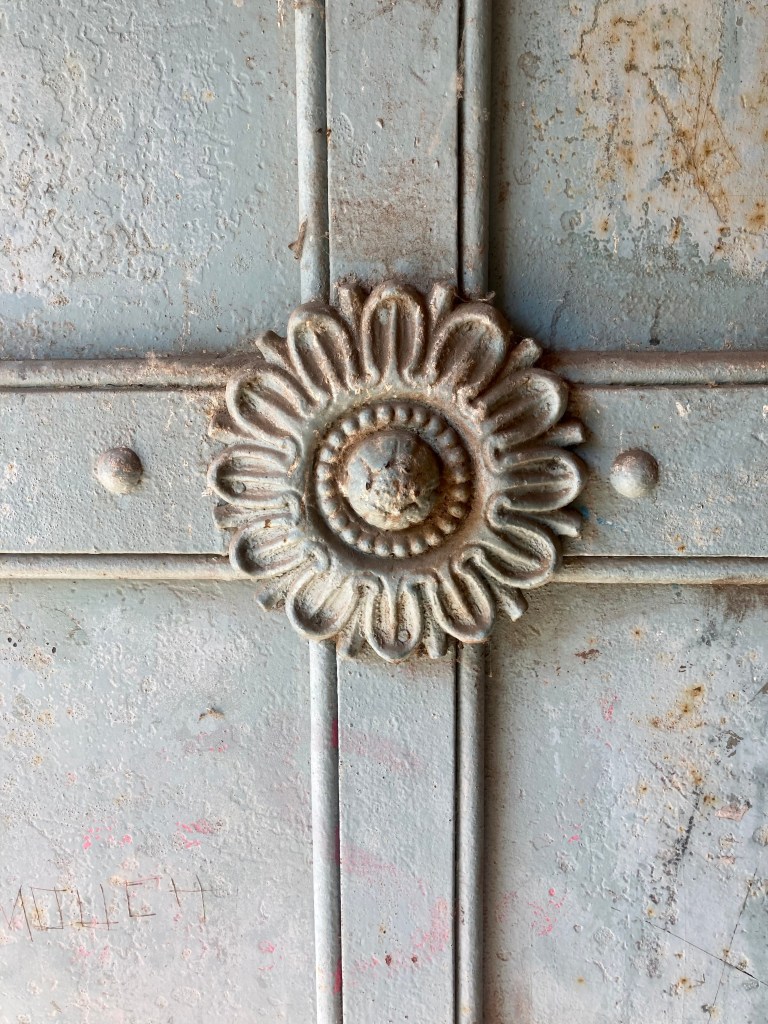

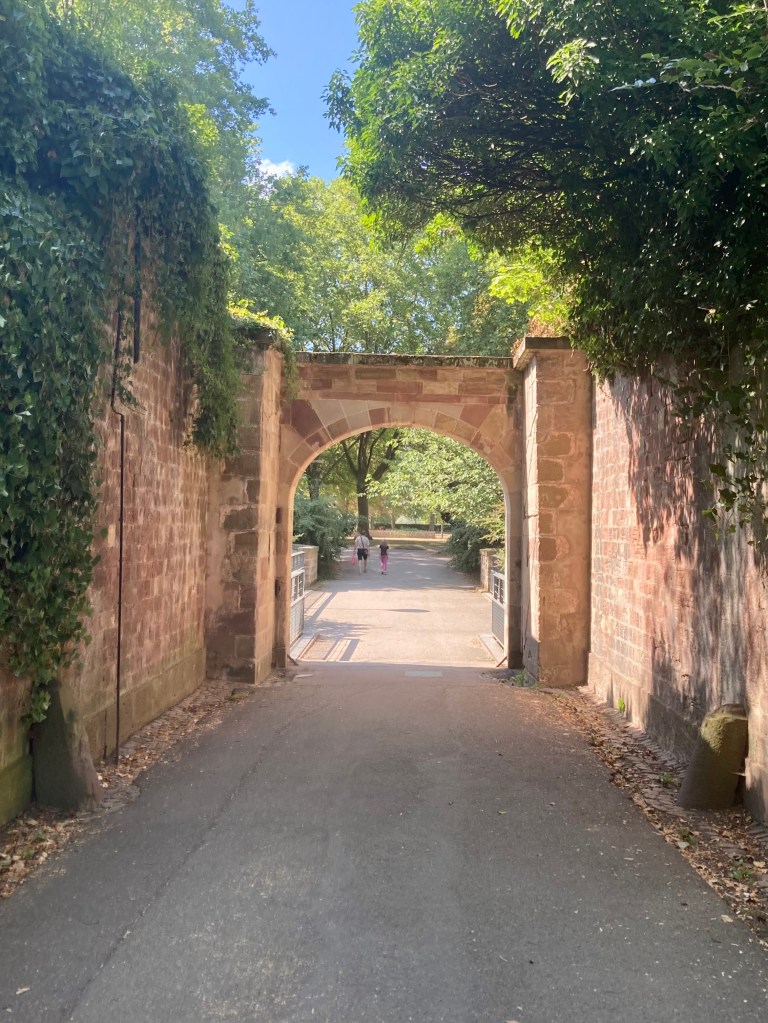

Then they were gone, and it was back to just Captain and Crew. On the way back from the station to see them off we walked oince more through the Citadel park which is immediately adjacent to the port.
Naturally it is a much quieter place now; soldiers replaced by coots and squirrels (including at least one red one!); guns replaced by shady trees and benches; parade grounds replaced by children play areas and paddling pool.
The original ramparts, moat and gateways now provide charismatic backdrops in every direction and it is such a cool place to walk during these sweltering summer days.
By now we had decided to return to the UK ourselves for most of August. Our planned route via Canal des Vosges could not happen for a while as there was not enough water.
And, more importantly, our niece was getting married and we wanted to be there!
So just 3 more evenings watching sunsets, and wondering if they heralded rain before we left.


The day we set off to our second home (Calliope feels like the first one) was blue and warm again.
Our journey of walk/tram/train/Eurostar/train/ ferry/taxi was accomplished in around 8 hours.
In less than 4 weeks we would make the return journey to continue our voyages!


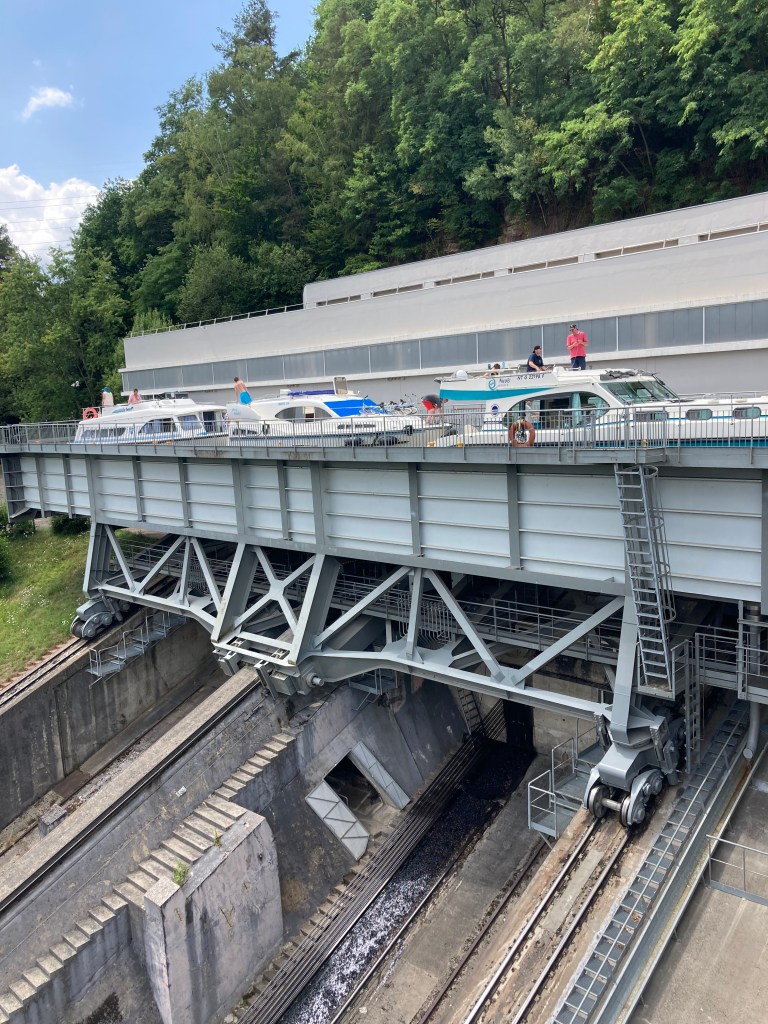









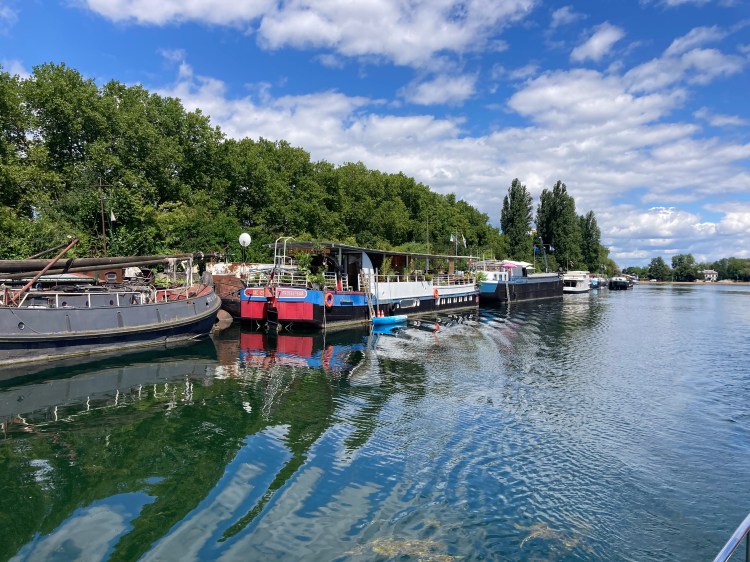


Hello! We have been devouring your blog because you go much farther than we do.
We are currently based in Strasbourg where it is difficult to find marine mechanical help.
You had mentioned that you know of a very talented mechanic who was mobile for the north of France. Could you please pass me his name so we may ask him if he could help us?
Enjoy your voyage!
LikeLike
Hi Steve. Thanks for your message. Strasbourg is a nice place to be stranded. Unfortunately my friend Ian, the talented marine engineer, has just sold his boast and (literally this week) is moving back to UK! But I know there is an engineer at the Europe Trading marina at Strasbourg – and I am fairly sure he is reliable. Are you a member of the Dutch Barge Association? I expect other members will have ideas too. According to their waterways guide there are shipyards at Mulhouse, not too far away – Mechanical services Pro’Bateaux (http://www.probateaux.fr/) and Nautilia (03 89 310 305). But I don’t know if they will travel. Sorry I cannot be more help. Lesley
LikeLike
I see that your site is very informative, and every article is better than any other website’s blog and articles. Your blog contains more information than any other. I think you are one of the best informative article writers, also I am sure you are.
LikeLike
Thank you Scott. You are very kind!
LikeLike